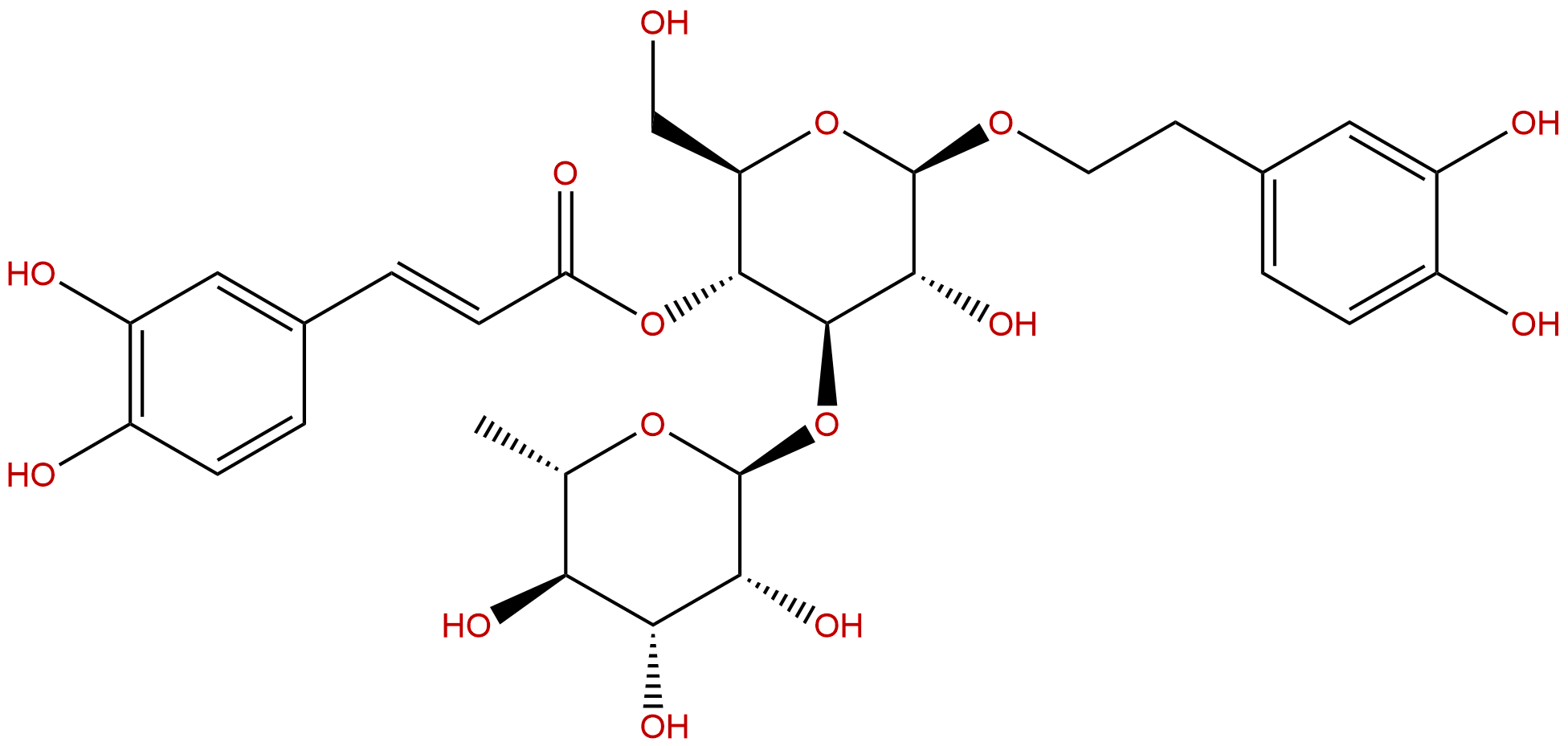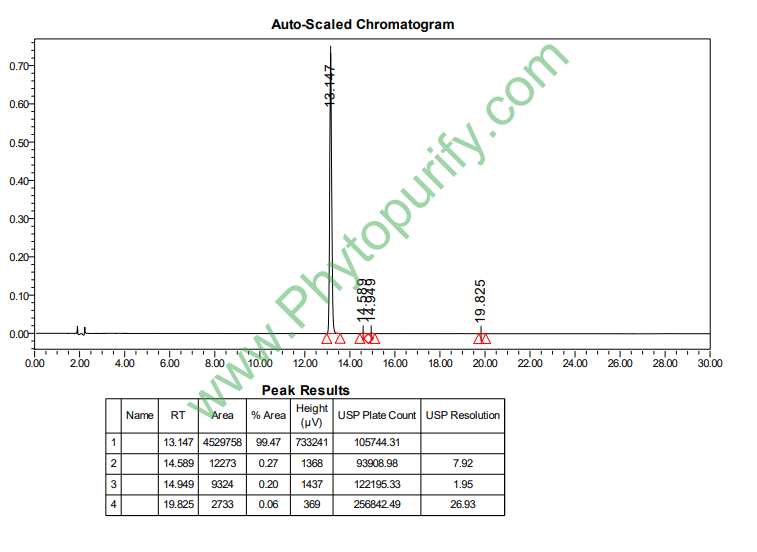
ActeosideCAS No.:61276-17-3
|
||||||||||
 |
|
|
||||||||

| Catalogue No.: | BP0124 |
| Formula: | C29H36O15 |
| Mol Weight: | 624.592 |
Product name: Acteoside
Synonym name: Verbascoside; Kusaginin
Catalogue No.: BP0124
Cas No.: 61276-17-3
Formula: C29H36O15
Mol Weight: 624.592
Botanical Source: Cistanches herba
Physical Description:
Type of Compound: Phenylpropanoids
Purity: 95%~99%
Analysis Method: HPLC-DAD or/and HPLC-ELSD
Identification Method: Mass, NMR
Packing: Brown vial or HDPE plastic bottle
The product could be supplied from milligrams to grams
Inquire for bulk scale.
Description:
Acteoside is a lipase inhibitor, has neuroprotective, anti-obesity,anti-inflammatory, antioxidant, anticancer, cytotoxic,antihypertensive, analgesic, and antimetastatic activities. Acteoside can promote nerve growth factor and tropomycin receptor kinase A expression, inhibit arachidonic acid release and prostaglandin E2 production induced by 0.5 microM melittin. Acteoside can protect the cells from X‑ray induced damage through enhancing the scavenging activity of ROS, decreasing the Bax/Bcl-2 ratio and downregulating the activity of procaspase-3, as well as modulating the mitogen‑activated protein kinase signaling pathways.
References:
Int Immunopharmacol. 2015 May;26(1):23-9.
Acteoside attenuates TSLP-induced mast cell proliferation via down-regulating MDM2.
Acteoside (verbascoside) is extensively distributed in Abeliophyllum distichum and has antimicrobial and anti-inflammatory properties. Thymic stromal lymphopoietin (TSLP) has a pivotal function in the pathogeneses of inflammatory diseases through increasing the mast cell proliferation via the activation of murine double minute 2 (MDM2). Here, we investigate whether Acteoside attenuates the MDM2 expression in a TSLP-stimulated human mast cell line (HMC-1 cells).
METHODS AND RESULTS:
In these cells, TSLP induced the up-regulation of MDM2 and the down-regulation of p53; however, in the TSLP-stimulated HMC-1 cells, the Acteoside down-regulated the MDM2 and up-regulated the p53. Increases in the phosphorylation of the single transducer and activation of transcription 6 and 5 via TSLP are decreased by Acteoside. The interleukin (IL)-13 (a mast cell growth factor), IL-6, tumor necrosis factor-α, and IL-1β levels are significantly reduced by the Acteoside in the TSLP-stimulated HMC-1 cells, and the Acteoside significantly induces the activation of caspase-3, the cleavage of poly-ADP-ribose polymerase, and the reduction of the procaspase-3 and Bcl2. Furthermore, the mRNA expressions of the TSLP receptor and IL-7 receptor that increase due to TSLP are reduced by the Acteoside.
CONCLUSIONS:
In conclusion, these results indicate that Acteoside is a specific regulator of MDM2 activation in TSLP-stimulated mast cells, which indicates its potential use for the treatment of mast cell-mediated inflammatory diseases.
Mol Med Rep. 2015 Apr 16.
Protective effects of acteoside against X‑ray‑induced damage in human skin fibroblasts.
METHODS AND RESULTS:
To investigate the protective effects of Acteoside against apoptosis induced by X-ray radiation in human skin fibroblasts (HSFs), the cells were divided into the following groups: Control group; X-ray radiation group; Acteoside group, in which the confluent cells were preincubated with 50 μg/ml Acteoside for 2 h followed by radiation; and positive control group, in which the cells were preincubated with 50 μg/ml paeoniflorin followed by radiation. For the radiation, HSF cells preincubated with Acteoside or paeoniflorin were exposed to X-ray beams at a dose-rate of 3 Gy/min (16 Gy in total). Cell viability, apoptosis and intracellular alteration of redox were monitored by MTT and flow cytometry. Compared with the radiation group, the number of cells arrested at the G0/G1 phase was significantly reduced in the Acteoside and paeoniflorin groups, respectively (P<0.05). X-ray radiation induced marked apoptosis in HSF cells and Acteoside reversed this effect. Compared with the radiation group, the generation of intracellular reactive oxygen species (ROS) was abrogated by pre-incubation with Acteoside or paeoniflorin (P<0.05). In addition, the upregulation of pro-caspase-3 induced by radiation was reversed by Acteoside or paeoniflorin. Radiation could induce upregulation of Bax and downregulation of Bcl-2; however, it was reversed completely after administration of Acteoside or paeoniflorin. Furthermore, the enhanced expression of ERK and JNK induced by radiation was reversed by Acteoside or paeoniflorin.
CONCLUSIONS:
Acteoside could protect the cells from X-ray induced damage through enhancing the scavenging activity of ROS, decreasing the Bax/Bcl-2 ratio and downregulating the activity of procaspase-3, as well as modulating the mitogen-activated protein kinase signaling pathways.
Life Sci. 2004 Jan 9;74(8):1051-64.
Protective effect of acteoside on carbon tetrachloride-induced hepatotoxicity.
This study investigated the protective effects of Acteoside, a phenylethanoid glycoside, on the carbon tetrachloride-induced hepatotoxicity as well as the possible mechanisms involved in this protection in mice.
METHODS AND RESULTS:
Pretreatment with Acteoside prior to the administration of carbon tetrachloride significantly prevented the increased serum enzymatic activities of alanine and aspartate aminotransferase in a dose-dependent manner. In addition, pretreatment with Acteoside significantly prevented the increase in hepatic malondialdehyde formation and the depletion of the reduced glutathione content in the liver of carbon tetrachloride-intoxicated mice. Carbon tetrachloride-induced hepatotoxicity was also essentially prevented, as indicated by a liver histopathologic study. The effects of Acteoside on cytochrome P450 (P450) 2E1, the major isozyme involved in carbon tetrachloride bioactivation were also investigated. Treatment of the mice with Acteoside resulted in a significant decrease in the P450 2E1-dependent pnitrophenol and aniline hydroxylation in a dose-dependent manner. Consistent with these observations, the P450 2El protein levels were also lower. Acteoside exhibited anti-oxidant effects on FeCl2-ascorbate induced lipid peroxidation in a mouse liver homogenate, and on superoxide radical scavenging activity.
CONCLUSIONS:
These results suggest that the protective effects of Acteoside against the carbon tetrachloride-induced hepatotoxicity possibly involve mechanisms related to its ability to block the P450-mediated carbon tetrachloride bioactivation and free radical scavenging effects.
Bot. Stud., 2012, 53(4):421-9.
Antioxidant and antihypertensive activities of acteoside and its analogs.
Acteoside (Act), a phenylethanoid glycoside, is an active compound in several plants and traditional herbal medicines. Act along with its structural isomer, isoActeoside (Isoact), and an analog, 6-O-acetylActeoside (6-O-acetylact), were used in the study to investigate the antioxidant, anti-angiotensin-converting enzyme (ACE), and hemolysis inhibitory activities in vitro and antihypertensive activity against spontaneously hypertensive rats (SHR) in vivo.
METHODS AND RESULTS:
We showed that Act, Isoact, and 6-O-acetylact effectively scavenged 1,1-diphenyl- 2-picryl-hydrazyl radicals (with IC50 at 11.4, 9.48, and 9.55 μM, respectively) and superoxide radicals (with IC50 at 66.0, 38.5, and 39.1 μM, respectively). As Isoact and 6-O-acetylact had similar radical-scavenging activities, only Act and Isoact were used for following studies. Both Act and Isoact inhibited xanthine oxidase activity with IC50 at 53.3 and 62.2 μM, respectively. Both Act and Isoact also significantly inhibited ACE activity and the hemolysis induced by 2,2'-azo-bis(2-amidinopropane)dihydrochloride, but the effects of Act were stronger than Isoact. We then orally administered a single dose of Act or Isoact (10 mg/Kg body weight) to SHR and measured the changes of systolic blood pressure (SBP) and diastolic blood pressure (DBP) over 24 h. Act, but not Isoact, showed antihypertensive activity in lowering SBP and DBP.
CONCLUSIONS:
The results suggest the potential usefulness of Act as a health food product for antioxidant protection and blood pressure regulation.
HPLC of Acteoside
